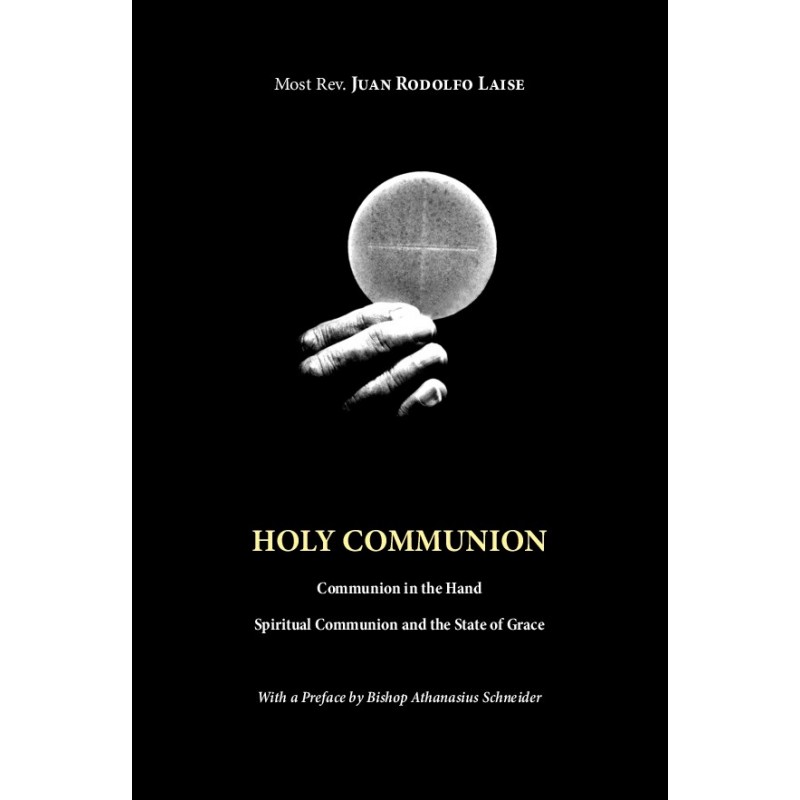Bishop Juan Rodolfo Laise, OFMCap.,
Defender of the Holy Eucharist
R.I.P.


The Argentine Catholic new agency AICA/InfoCatólica posted a headline on July 24 reading: “Condolences of the Pope on the death of Bishop Juan Rodolfo OFMCap.” The article is especially significant because of its final paragraph on Bishop Laise’s book Communion in the Hand: Documents and History. But we present here the full context of the article, in order to illustrate why Bishop Athanasius Schneider described Bishop Laise as “the prophetic voice of an elderly bishop,” and “the glory of the bishops of Argentina” (“decus episcoporum Argentinae”).
The article began as follows:
Pope Francis sent his condolences on the death of Bishop Juan Rodolfo Laise OFMCap, Bishop Emeritus of San Luis, which occurred on Monday, July 22, in San Giovanni Rotondo, Italy.
The telegram with the condolences of the pontiff was sent by the Vatican Secretary of State, Cardinal Pietro Parolin, to the current bishop of San Luis, Bishop Pedro Daniel Martínez Perea, through the apostolic nunciature.
The AICA report continued by stating that the Argentine Episcopal Conference used Twitter to express “its sorrow and firm hope in the Risen Lord” on learning the news of Bishop Laise’s death. AICA then cited the words spoken at Bishop Laise’s funeral in Italy by Archbishop Franco Moscone of Manfredonia-Vieste–San Giovanni Rotondo, who named seven “calls” that Bishop Laise received during the course of his life: his birth whereby he was made in the image of God, his baptism making him a son of God, his call to the religious life making him a son of Saint Francis, his fourth call to the priesthood, his fifth call as a bishop and successor of the Apostles, a sixth call as a confessor like St. Padre Pio, and his seventh call to eternal life.
Adding to the memories of him from his fellow bishops is a pastoral letter cited by AICA, and written by Bishop Laise’s current successor, Bishop Pedro Daniel Martínez Perea. AICA cites Bishop Martínez Perea as follows:
“We especially value, among other activities, his love for the Eucharist, his Marian devotion, realized in each town; his ecclesial concern for vocations, embodied in the founding of the Saint Michael the Archangel Diocesan Major Seminary; and his fidelity to the Catholic doctrine of the Magisterium of the Church,” he said.
Likewise, he emphasized “his constant efforts to maintain and highlight the sacredness of the liturgy, restoring the cathedral church and promoting sacred chant; his solicitude for Catholic education; his particular devotion to Padre Pio, with the creation of prayer groups.”
The AICA article concludes under a subtitle referring to his “exquisite care for the sacraments.”
Bishop Laise was born in the city of Buenos Aires on February 22, 1926. He made the solemn profession in the Franciscan Order of the Capuchin Friars Minor on March 13, 1949, and was ordained a priest in the Euskal Echea de Llavallol School chapel, Province of Buenos Aires, on September 4 of that year by Bishop Miguel de Andrea, titular bishop of Temnos.
On July 6, 1971, he became the fourth bishop of San Luis, a diocese that had been created in 1934 by Pope Pius XI, succeeding Bishop Carlos María Cafferata.
Based in Italy, his retirement years were spent in the Shrine of San Giovanni Rotondo, known for being the monastery where Saint Padre Pio de Pietralcina lived throughout his life. There each day he served for one of the four periods for confession, arranged to attend the many pilgrims who arrive there….
Among his many works, outstanding is his book Communion in the Hand: Documents and History, originally published in 1997, where he explains the reverence that each of the faithful must give to the Blessed Sacrament when they receive Communion. With irrefutable proof he concludes that the only way to manifest sincerely with word and gestures the faith in the Eucharistic presence of the Lord is to receive Communion on the tongue, directly from the hands of the priest. In fact, in his diocese it was forbidden to receive Communion otherwise.

The wording of this final paragraph was taken from the web site of the Argentine Una Voce, an association which is especially qualified to describe Bishop Laise’s work in defense of the traditional rites of the Church. The original title of his book was the one cited above: Communion in the Hand: Documents and History. But in the final year before his death Bishop Laise added another section to the book, expanding his defense of the reverence due to the Holy Eucharist. He gave the book a new title, Holy Communion, with the original title and the new section title as subtitles. The book in its original form focused on the external respect required to receive Communion, and the defense of the Church’s liturgical laws making Communion on the tongue the norm for the universal Church. But the new section added by Bishop Laise is devoted to the interior dispositions required for receiving Communion, and to this new part of the book His Excellency gave the title: Some Reflections on Spiritual Communion and the State of Grace. God’s mercy toward those who fall into sin can never be interpreted as permitting Communion when someone is not observing the Commandments. The laws of God do not represent an unachievable burden, but a necessary guide to enable the faithful to receive Communion worthily. Both in the external rite whereby the faithful receive Communion on the tongue, and not in the hand, and in one’s internal dispositions requiring not merely the state of grace but a fruitful preparation, Bishop Laise affirmed the constant teaching and practice of the Church, which have guided Catholic piety throughout all the centuries of the Church’s history.
HOLY COMMUNION
Communion in the Hand: Documents & History
Some Reflections on Spiritual Communion and the State of Grace
By Bishop Juan Rodolfo Laise, OFMCap
Preface by Bishop Athanasius Schneider
2018 218 pages hardcover $18.00 #63233
Click Here to Purchase
